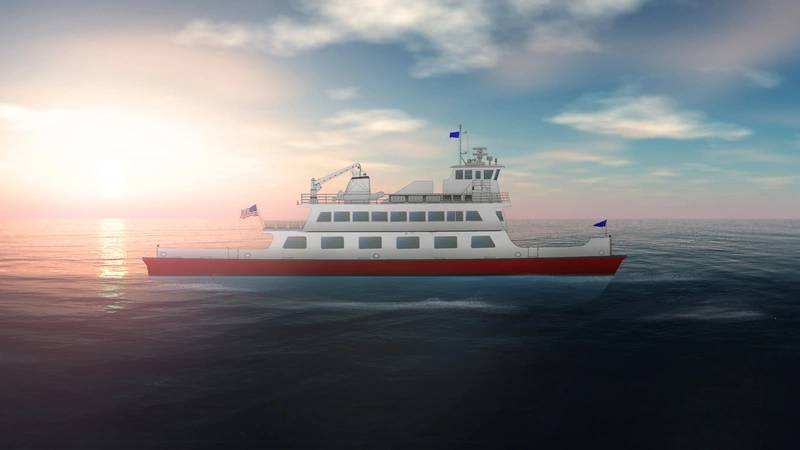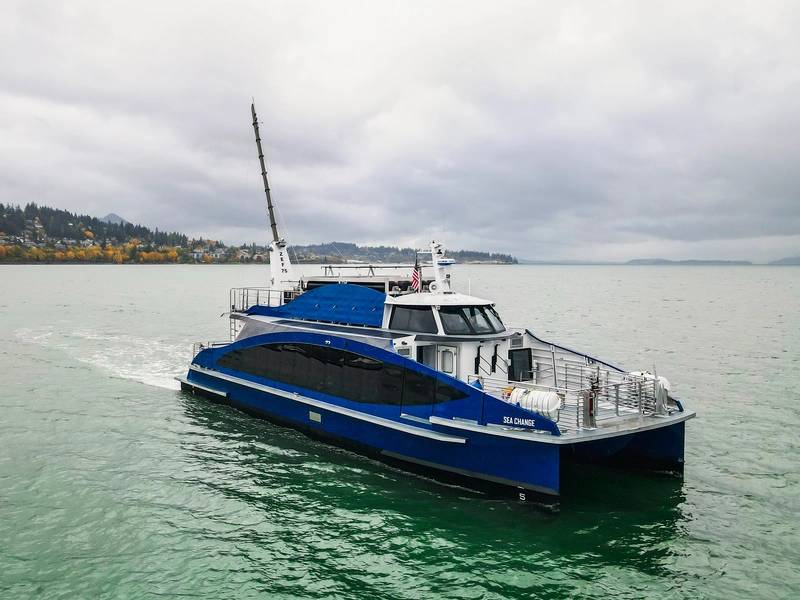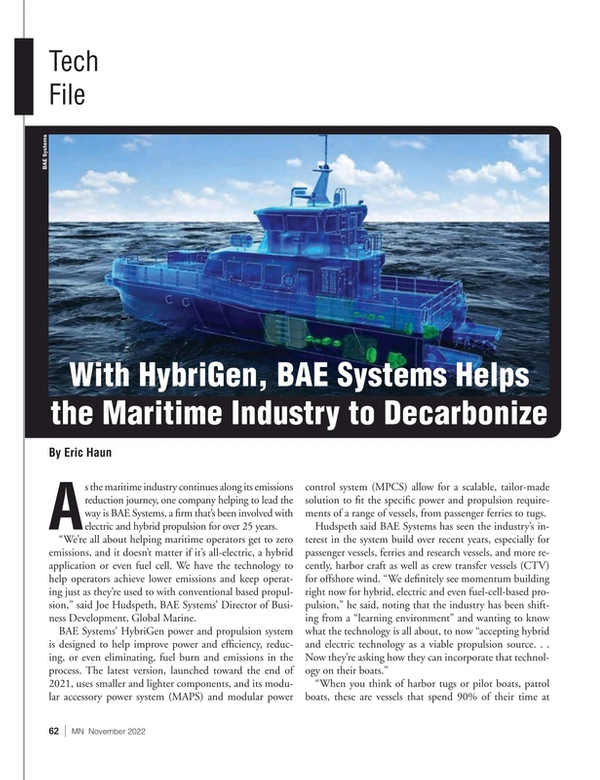
With HybriGen, BAE Systems Helps the Maritime Industry to Decarbonize
As the maritime industry continues along its emissions reduction journey, one company helping to lead the way is BAE Systems, a firm that’s been involved with electric and hybrid propulsion for over 25 years.
“We’re all about helping maritime operators get to zero emissions, and it doesn’t matter if it’s all-electric, a hybrid application or even fuel cell. We have the technology to help operators achieve lower emissions and keep operating just as they’re used to with conventional based propulsion,” said Joe Hudspeth, BAE Systems’ Director of Business Development, Global Marine.
BAE Systems’ HybriGen power and propulsion system is designed to help improve power and efficiency, reducing, or even eliminating, fuel burn and emissions in the process. The latest version, launched toward the end of 2021, uses smaller and lighter components, and its modular accessory power system (MAPS) and modular power control system (MPCS) allow for a scalable, tailor-made solution to fit the specific power and propulsion requirements of a range of vessels, from passenger ferries to tugs.
Hudspeth said BAE Systems has seen the industry’s interest in the system build over recent years, especially for passenger vessels, ferries and research vessels, and more recently, harbor craft as well as crew transfer vessels (CTV) for offshore wind. “We definitely see momentum building right now for hybrid, electric and even fuel-cell-based propulsion,” he said, noting that the industry has been shifting from a “learning environment” and wanting to know what the technology is all about, to now “accepting hybrid and electric technology as a viable propulsion source. . . Now they’re asking how they can incorporate that technology on their boats.”
“When you think of harbor tugs or pilot boats, patrol boats, these are vessels that spend 90% of their time at less than 50% of their installed power—a lot of loitering time. And that loitering time leads to excess and unnecessary emissions,” Hudspeth said. “So why not do that with all-electric emissions-free power?”
Another key area of opportunity for BAE Systems’ HybriGen is in the CTV segment. “We see North America really gearing up to get into the offshore wind industry,” Hudspeth said. “If you’re going to a green form of power generation for our homes and businesses, certainly the vessels that are out there tending to those wind farms should also have similar low emissions, low carbon footprint propulsion systems as well.”
Among the most noteworthy applications for the HybriGen system is the Sea Change, America’s first hydrogen fuel cell powered vessel. And BAE Systems has secured a number of notable orders across the globe in recent months. In the U.S., it was tapped to supply its solution to deliver reduced and zero-emission operations capability for a new hybrid-electric passenger vessel being built by North Kingstown, R.I. shipyard Senesco Marine for the Maine State Ferry Service (MSFS).
 BAE Systems’ HybriGen Assist system will be installed on a new hybrid-electric passenger vessel for the Maine Department of Transportation’s Maine State Ferry Service (MSFS). (Image: Senesco Marine)
BAE Systems’ HybriGen Assist system will be installed on a new hybrid-electric passenger vessel for the Maine Department of Transportation’s Maine State Ferry Service (MSFS). (Image: Senesco Marine)
“For this particular project, we’re using a parallel-based hybrid propulsion system,” Hudspeth said. “It has a conventional propulsion power plant installed on board the vessel, which is supplemented by electric propulsion. We actually use all-electric, zero-emissions propulsion for the vessel to be at the dock while the cars and passengers are loading. It’s done completely emissions free. And this particular boat, the vessel needs to hold itself against the dock and have propulsion remain engaged. And we can do that completely quiet, vibration free and emissions free. And then when the vessel departs the dock and leaves the harbor, it also can do that under all-electric propulsion until it gets underway at the full cruise speed. Then it will use conventional based propulsion. And that’s all done through a seamless transition. The captain just needs to focus on driving the boat. Everything is fully automated.”
The system will also be able to provide a boost when power needs surpass what the conventional propulsion can supply. “Our electric propulsion can work in conjunction with that diesel propulsion and provide boosting power even to higher horsepower ranges,” Hudspeth said. “That’s a unique feature of a parallel-based hybrid propulsion system.”
In addition to the parallel-based hybrid propulsion setup, HybriGen can also be used in full electric applications or even hybrid applications that use serial hybrid propulsion. The scalable system can be customized to provide all necessary power for both propulsion loads and auxiliary power hotel loads. “It really is a modular and flexible platform and gives us a lot of capability,” Hudspeth said. “We can even use this same system to facilitate all of the charging for the batteries.”
While HybriGen’s modularity and scalability help BAE Systems to tailor the system for a wider range of vessels and operational profiles, these characteristics also help the company to cater to customers at all stages of the decarbonization movement. “We realize this is a journey. Not everyone is ready to get to zero emissions today,” Hudspeth said. “We can offer a hybrid solution that uses diesel as a source for power generation. Or we can use that same HybriGen technology for all-electric, simply add more batteries. The great thing is people can start out with a hybrid solution today and very quickly in the future, transition to all-electric, simply by adding more power through batteries or tapping into shoreside charging infrastructure to recharge those batteries.”
 Among the most noteworthy applications for the Hybrigen system is the Sea Change ferry, America’s first hydrogen fuel cell powered vessel. (Photo: All American Marine)
Among the most noteworthy applications for the Hybrigen system is the Sea Change ferry, America’s first hydrogen fuel cell powered vessel. (Photo: All American Marine)
Of course, a number of challenges come with the territory for hybrid and electric vessel projects, as is the case for the adoption of any “new” technology. For battery-electric vessels in particular, Hudspeth said, “One of the main challenges is many of the piers and docks in which these vessels operate have not been properly set up to accommodate the infrastructure for shore side charging. . . It’s going to take some time for this infrastructure to develop, but we think that there are solutions that are available today that can help people get into operations with lower emissions.”
Another challenge, according to Hudspeth, is upfront costs that are typically higher than traditional propulsion options. “The cost typically is at a premium, but if you look at the total cost of ownership, you will find that considering hybrid, electric or even fuel-cell-based propulsion certainly does have a payback. And that payback is both in the form of tangible lower operational costs, but intangible benefits as well. . . We can help walk through operators while they’re considering the total cost of ownership and showing them what they can expect with an alternative propulsion system.”
Hudspeth noted lower noise, decreased vibration and the ability for vessels to operate safely in sensitive coastal environments among key benefits. The HybriGen can also be used with geofencing technology that allows vessels that may be using hybrid propulsion to go into an all-electric emissions-free mode anytime they enter into a specific GPS defined boundary, Hudspeth said. “There is no need to push buttons or pull levers. It’s done automatically and you can ensure that the vessel is operating with a lower carbon footprint in those sensitive coastal environments.”
Read With HybriGen, BAE Systems Helps the Maritime Industry to Decarbonize in Pdf, Flash or Html5 edition of November 2022 Marine News
Other stories from November 2022 issue
Content
- US Mid-term Elections Bring Changes, Uncertainty in Congressional Maritime Leadership page: 18
- Recruiting Gen Z in the Marine Industry page: 21
- Great Lakes Winter Supply Chain – A Cause for Concern page: 24
- Alternative Fuels, Newbuilds and Retrofits are Key to Marine Industry Growth page: 27
- Fortunes Return to the Sea as the Wind Blows Offshore page: 30
- US Inland Waterways: Looking for Rainmakers page: 34
- Infrastructure Improvements Set to Boost Efficiency at Lock and Dam 25 page: 40
- Marine News' Top Vessels of 2022 page: 44
- With HybriGen, BAE Systems Helps the Maritime Industry to Decarbonize page: 62


